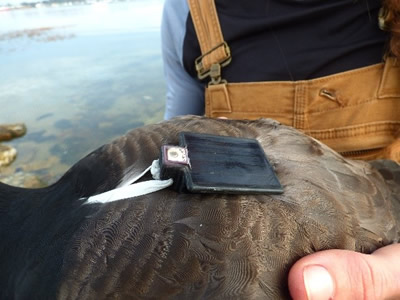  |
Atlantic Brant Migration and Breeding Ecology Study |
|
March 13, 2018
During February 2018, the NJDEP Division of Fish and Wildlife kicked-off a 5-year collaborative Atlantic brant migration and breeding ecology study with the New York Department of Environmental Conservation and the Canadian Wildlife Service.
Atlantic brant are a small goose species that breeds in northern Canada and winter in the mid-Atlantic region of the United States. About 90% of the entire population winters along the coast of New Jersey and New York! During the next two years, crews will be marking brant with GPS transmitters and tiny geolocators. The geolocators are attached to a red and white plastic leg band.

Atlantic brant with tarsal band |
|

Atlantic brant with GPS backpack marker and geolocator |
This study is using GPS backpack and tarsal geolocators during 2018-19 on both the wintering grounds in New Jersey/New York and breeding grounds in Nunavut, Canada. Marked birds will provide insight into the following Atlantic brant questions:
- During winter, are brant distributed in the same areas as the Mid-Winter Waterfowl Survey? If so, the survey is representative of the wintering population; if not, adjustments to the geographic coverage of the MWS need to be made.
- How faithful are brant to wintering areas within and among years?
- What is the breeding propensity of Atlantic brant?
- What is the age at first breeding for Atlantic brant?
- What are the key staging areas used during spring and fall migration and is there annual variation in these stopover sites?
- Is there a relationship between spring phenology, timing of nesting, and timing and rates of movement?
- How faithful are brant to breeding areas among years?
- Do brant molting at the locations currently marked during the summer period use the same wintering and/or migration areas? Do they have the same migration timing?
- Are the current Atlantic brant preseason (summer) banding stations adequately or reasonably reflect the wintering distribution of brant?
If one of these red leg bands is seen in the field, please report the observation to the Patuxent Wildlife Research Center Bird Banding Laboratory. If one of these brant is recovered during the hunting season or is found dead, please call 609-628-3218 so we can recover the data from the geolocator unit. The information obtained from geolocator units is vital to the success of the study. We appreciate the cooperation of the public.
|


